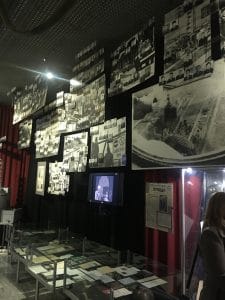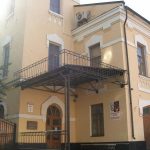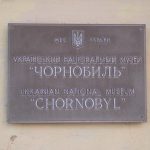The Chernobyl nuclear disaster of 1986 is memorialized in a small but powerful Chernobyl Museum in central Kyiv. Students on SRAS study abroad programs in Kyiv are often taken there as part of their cultural package as the tragedy remains fresh in Ukrainian memories and continues to be a important part of local history and identity formation.
Below are two experiences that SRAS students had on excursions to the Chernobyl Museum.
Charlie Bacsik (2017)
While studying abroad in Kyiv, I have visited a handful of museums around the city, and it’s safe to say the National Chernobyl Museum is one of my favorites. The well-known 1986 Chernobyl disaster is one that I had heard quite a bit about, but not studied closely. With this being said, my tour of the National Chernobyl Museum was as educating as it was heartbreaking.
The excursion was included in the PCON program, but if you find yourself visiting the museum by yourself, be sure to request a guided tour in either Russian or English. There are very few descriptions given to the displays, so following the flow of the museum could be difficult without a guide.
The museum itself is fairly small, but it is literally covered ceiling to floor in photographs, documents, and information from the Chernobyl crisis presented in a very modern style, with bright colors and moody, directional lighting. Our amazing tour guide explain the significance behind all of the artifacts including uniforms used during the clean-up, pictures of the victims affected by the radiation, documents and newspapers describing the event, and several models explaining what exactly happened on April 26th, 1986.
After the fourth generator of the Chernobyl Nuclear Power Plant ignited, fumes from the explosion started spreading across the Soviet Union and Europe. It wasn’t until 36 hours after the meltdown when officials decided to evacuate surrounding areas. The closest town to the Chernobyl Power Plant, Pripyat, evacuated 49,000 people, while the town of Chernobyl evacuated an additional 68,000 people. Both towns remain predominantly vacant to this day, excluding a handful of older families who returned to their homeland in the past years.
Over 500,000 workers were assigned to the cleanup and shut down of Chernobyl. Many workers were given small radiation detectors to monitor their exposure throughout their work shifts. As the cleanup process began, countries from around the world stepped in to assist. The UN also played a key role in humanitarian aid and medical assistance to those harmed from the radiation. Shortly after the disaster, 50 employees passed away from acute radiation syndrome, and 15 children passed from thyroid cancer. The Chernobyl Forum, a group of nine UN-sponsored organizations that assesses the medical and environmental effects surrounding Chernobyl, believes close to 4,000 people have since passed from radiation-induced cancer and leukemia.
The Chernobyl Museum doesn’t just focus on remembering the disaster of 1986, but it makes a strong effort to remind the public of those affected by the aftermath. The museum houses a memorial specifically for the children who battled cancer caused from the disaster, as well as a memorial for all those who fell ill after assisting in the cleanup. The museum also brings light to the strength and charitable assistance of all those who fought through the crisis. The museum, through exceptional memorials and commemorations, found an excellent way to honor those affected, as well as show supreme gratitude for all of the helping hands that came from across the globe. In my opinion, the National Chernobyl Museum is one of the most impactful and resonating exhibits in Kyiv.
Note: Tours to Chernobyl and to the abandoned city of Pripyat can be arranged through various venders in Kyiv. The museum even lists one as a partner. The all-day tours include train rides to and from the locations, and cost around $100. Most services require a minimum party of 2.
Charlie Bacsik
Marie Forney (2013)
The Chernobyl disaster of 1986 can hardly be viewed as a forgotten event of the past here in Kyiv. After-effects of the tragedy linger on as ominous reminders of man’s potential to cause catastrophic disaster, whether accidentally or intentionally, and for Ukrainians, the horrific events create a before and after division of the nation’s history. The other night, I met a woman at the ballet theater who introduced herself to me with her name, followed by “born eleven days after Chernobyl,” and it seems no more than two days go by without my ears hearing “Chernobyl” when I’m at school or around Kyiv City.
I had the opportunity to visit the National Chernobyl Museum with my peer language coach from the NovaMova Language School, where my classes in Kyiv with SRAS are held. The two of us took the metro to Kontraktova Station and walked along the cobble-stone streets to an old firehouse. The worn yellow building still prominently displays a look-out tower from which fire-fighters would catch sight of city fires and ring a bell of warning. This monitorial structure with its historical destruction-combating function seems a fitting place to memorialize the Chernobyl disaster, which remains the most severe radio-ecological disaster of the 20th century.
Upon entering the Chernobyl Museum, my peer coach and I were welcomed by a presentation of photographs on walls and rows of 76 signs hanging from the ceiling, each one displaying the crossed-out name of a village that was evacuated and abandoned because of the Chernobyl tragedy. We purchased admission tickets and proceeded up a staircase to the main exhibits. Images of red apples lined each step of the passageway, introducing us to a symbol that recurs throughout the exhibitions. The vivid red fruits seemed to artistically roll toward us on the road to Chernobyl, recalling the biblical tree of life and all the lives lost by the explosion and radiation. At the top of the staircase stood the framework of a church wall and banners of religious icons, all transported from the Church of St. John in Dlinny Les village – one of the sites abandoned because of the disaster.
The highly-artistic presentation of exhibits then combined with equally technical displays of historical information: a three-phase diorama demonstrating the before, during, and after appearance of the Chernobyl nuclear power plant, interactive maps, and three-dimensional models that track the location and levels of destruction. Primary “Top Secret” documents, relics from the Exclusion Zone, photographs, documentaries, and examples of the disaster relief effort added chilling gravity to the museum experience. I couldn’t help but feel somber as I took it all in and listened to my peer coach tell me all she knew about the tragic events, tears seeping from the corners of her eyes as she related her insights and translated some of the Ukrainian exhibits for me.
All-in-all, the Chernobyl Museum’s seven thousand plus exhibits create an informative and emotional portrayal of the events and effects of the disaster. While taking a tour of the Exclusion Zone in Chernobyl might give a more up-close-and-personal experience of the tragedy, I’m told that this kind of first-hand visit to the primary radiation site is regarded as dangerous by some, as well as more costly and less convenient than visiting Kyiv’s National Museum of Chernobyl. I highly recommend that visitors to Kyiv prioritize a trip to the museum as a way to better understand an aspect of Ukrainian history that largely impacts present day Ukraine. Although it might not be the most joyful of excursions, the education and insight are well worth an hour and few dollars. Before leaving, museum visitors are encouraged to write a short message or simply sign their name in a book commemorating the Chernobyl disaster victims and heroes. I found myself at a loss of words to leave in the book, but I nevertheless added a short message of appreciation and condolence for all those who sacrificed parts or all of themselves in the aftermath of the disaster.
Also, when I was viewing the exhibits, a group of about 20-30 people were taking advantage of a staff-led tour in Ukrainian. They comfortably moved about the museum, looking at the displays and listening to the tour guide as she provided additional information and insight about Chernobyl. I was fortunate enough to temporarily join the group and catch some phrases of the guide’s quickly-spoken Russian-language presentation, and although I couldn’t understand everything she said, I could tell that she was incredibly knowledgeable and passionate about the Chernobyl history and museum.
Marie Forney
More Pictures of the Chernobyl Museum in Kyiv
Marie Forney



















